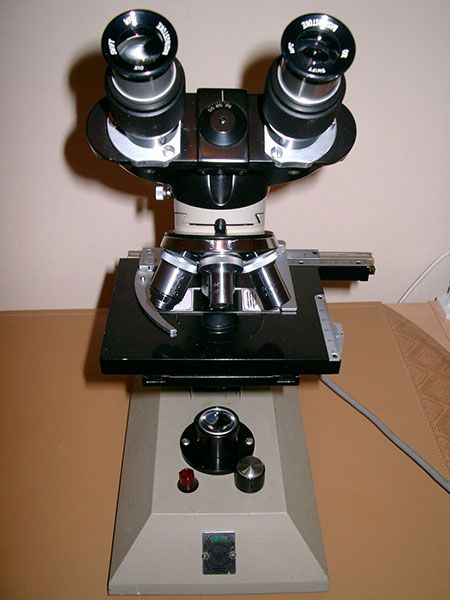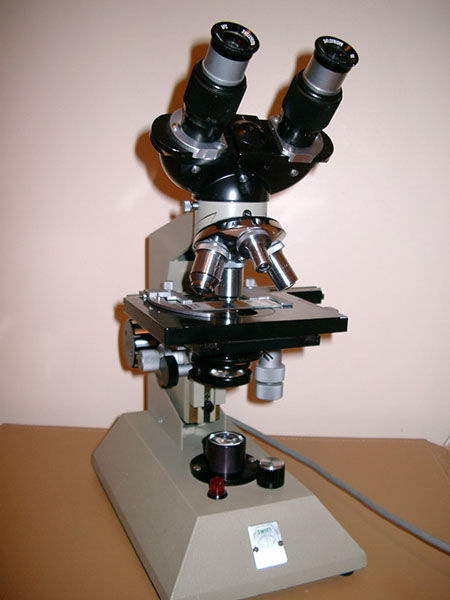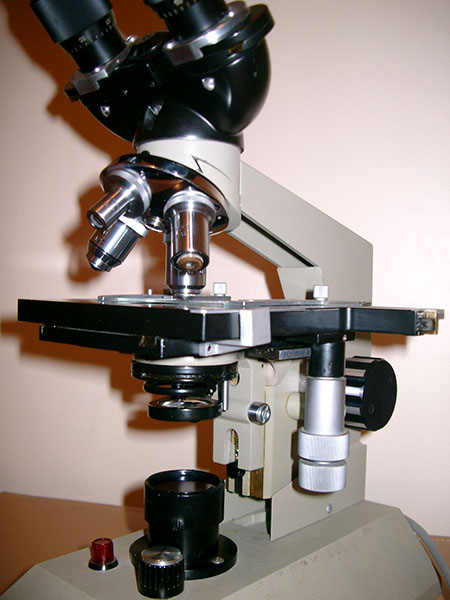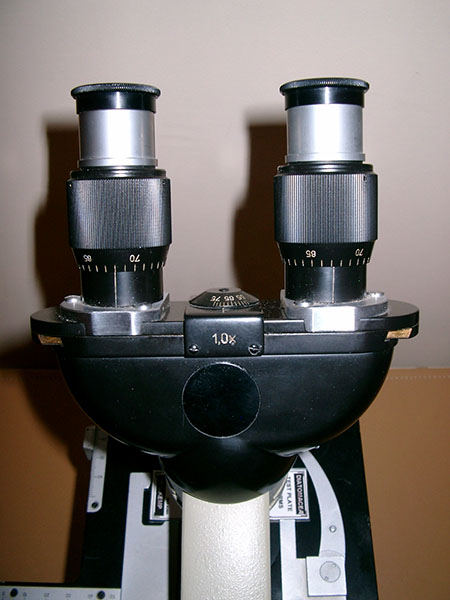

ANATOMY OF A LESSER KNOWN ‘LOMO’ MICROSCOPEby Douglas Downer-Smith, UK |
Before I describe this interesting microscope in detail, let me first explain why I have used the term ‘LOMO’. The microscope stand is without any of the normal markings typical of LOMO. There is not a logo or serial number on the plate over the fine focus mechanism, or the aluminium plate usually found on the side of the limb. Despite these omissions, the physical appearance is that of essentially a standard LOMO microscope. The interesting element of the microscope is the addition of a lighting base, an excellent binocular head complete with a pair of wide-field eyepieces. The microscope is badged “Swift, Basingstoke, England”.


Let us take a look more closely at the microscope starting with the binocular head. Unlike the standard LOMO model, this is inclined at approx. 45o. Remembering my first LOMO microscope, and being a tall person, it was the crouching I had to do, as I recall, to view with any visual comfort. But the differences do not stop there. The magnification factor is x1 and the interocular adjustment is made by pulling on each side of the assembly. There is a centrally placed dial on which there is a figure and is the approximate inter-pupillary distance in mm. This figure is used to adjust each drawtube to the same number. Due to the mechanical design, as the inter-pupillary distance increases, the eyepiece drawtube length is physically reduced by the user to maintain the required tube length. Now here is the real interesting bit, the eyepiece tube adjustment possible is between 55 and 75 mm., so as each tube is individually adjusted, the degree of adjustment still available will allow many millimetres of tube length adjustment either way. This of course, provides adjustment for cover-glass thickness but will also allow different tube length objectives to be used – for example, 170mm Leitz objectives. The final point to note is the inclusion of two very good x10 WFC Swift eyepieces. Although not marked as such, they are in use, look and feel, a modern example of the well known (and much sought after, as I recall!) Telaugic pattern of Swift eyepieces. Frankly, the field of view is excellent with a comfortable high eyepoint for spectacle wearers.


Moving on to the main components of the limb, focussing assembly, condenser substage and stage, these are all LOMO manufacture. The mechanical stage is of the type known as the ‘research’ pattern if my memory serves me correctly. Notable is the removable section revealing essentially an oblong aperture in the stage in order that the LOMO Light Field/Dark Field condenser can be utilised. The condenser is the usual Abbe model with swing-in auxiliary lens for low power objectives. The substage is again standard LOMO except with a plug in place of where the mirror stalk would normally be placed. Having inspected all of the internal gearing on the coarse and firm focus assemblies, all these are standard LOMO – including some of the grease!
There are two modifications on the limb. The first are larger knurled knobs fitted with two countersunk screws attaching these to the original LOMO coarse focus knobs. This imparts a much better feel to the course focus. The coarse focus mechanism has essentially the second modification. Unlike the standard LOMO this microscope has the limb attachment to the base made with a four screw ‘stand off’ into the limb itself and not the fine focus slide. This arrangement changes the usual sense of the course focus in that turning the knobs in a clockwise direction (or away from you) causes the stage to descend. This seemed an odd feeling to start with but with practise this soon becomes comfortable. Also of help here is that the objectives are reasonably par focal/central and the x40 and x100 OI objectives have spring mounts being standard LOMO.
Now to the best part of the microscope – the base. The built-in lighting is based on a 6v 20W halogen bulb being controlled by a rheostat with a power on/off red indicator lamp. The rheostat is switched so the bulb is never put under the stress of being turned on with full voltage and current. This method ensures long bulb life. The lamp condenser is a two-lens affair. The initial collector lens is finely frosted (or possibly etched) with a secondary lens above it. Together, the lamp condenser with the bulb correctly positioned provides a visual field of even illumination. Inspecting the wiring and construction of the circuit board for the lamp control, all is certainly production standard.
How well does the microscope function? In short - very well. The illumination and condenser is more than good enough to fill the back lens of the dry x40 objective. The 20W bulb and rheostat control is enough to fulfil the requirement of an oil dark ground condenser in conjunction with the LOMO x90 oil objective. Without a funnel stop, the oil dark ground provides a good account of itself in a circular oblique configuration. Using a dry dark ground condenser, all of the LOMO dry objectives (x8, x20 and x40) work well with enough brightness in hand to control the dark ground effect. Using a phase condenser, the x40 objective gave a very good image using the x100 phase plate.
In summary, this is an excellent microscope principally due to its lighting base. The ability to alter tube length to correct for cover glass thickness is a valuable asset. The improvements instigated in this model make this microscope a joy to use from a better posture when using the binocular head and the lack of confinement around the substage area. This is particularly noticeable when manipulating oblique and phase condensers. The substage condenser is a nominal 37mm diameter and will take condensers from other manufacturers like Kyowa, Olympus and the like, whose ‘37mm’ is somewhat less than this figure. The overall height of the microscope is approximately 37cm. All of the objectives worked very well on my diatom and cytological slides. I had quite forgotten how good these objectives are especially the x40 dry. Contrast was excellent throughout the range of objectives with really good resolution for their numerical apertures. The x20 and x40 in particular retained contrast and resolution even at almost full aperture. A testament I am sure to the essentially Zeiss designs employed.
When was this microscope made? Unfortunately the stand does not carry the usual LOMO logo and serial number plate held in place by two screws covering the spring tensioner of the fine focus mechanism. The objectives are prefixed with different year numbers (72, 77, 78 and 88) so therefore not a reliable indicator of year of manufacture is present. I have not seen one of these re-badged/re-engineered microscopes before, so would welcome any reader feedback please as it is a model that is hitherto unknown to me.
Judging by the number of microscopes and accessories now being offered on the Internet by RAF Camera and eBay, interest in LOMO is increasing. Perhaps then this microscope deserves a place in the history of the LOMO microscope but any information, views or comments would be appreciated.
Comments to the author Douglas Downer-Smith are welcomed.
Published in the January 2009 edition of Micscape.
Please report any Web problems or offer general comments to the Micscape Editor .
Micscape is the on-line monthly magazine of the Microscopy UK web site at Microscopy-UK
©
Onview.net Ltd, Microscopy-UK, and all contributors 1995
onwards. All rights reserved.
Main site is at
www.microscopy-uk.org.uk
with full mirror
at
www.microscopy-uk.net
.